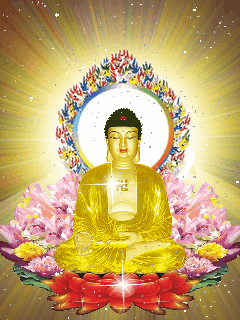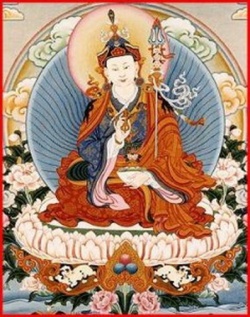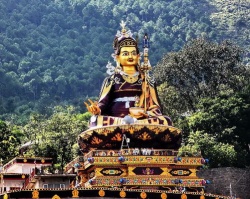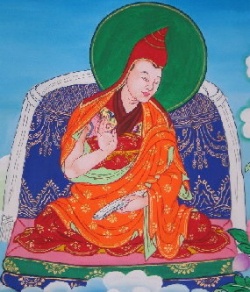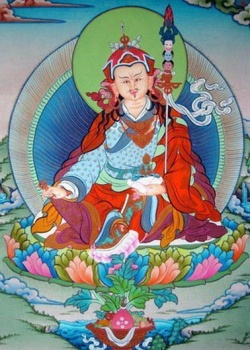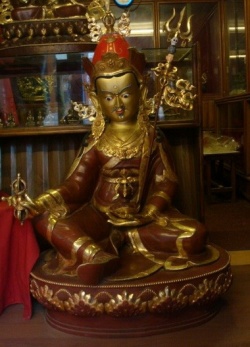Chagme Raga
The name Karma Chagme refers to a 17th-century Tibetan Buddhist (Vajrayāna) lama and to the tülku (reincarnate lama) lineage which he initiated. Including the first, seven Karma Chagme tülkus have been recognized. The Neydo Kagyu (Wylie: gnas mdo bka' brgyud) sub-school of the Karma Kagyu was established by the first Karma Chagme, Rāga Asya.
The First Karma Chagme, Rāga Asya
Karma Chagme (born Wangdrak Sung; ordained Karma chags-med; alias Rā-ga a-sya; 1613-1678), was born in Salmo Gang (Wylie: zal-mo sgang), a place near Riwoche Wylie: Ri-bo-che) in the district of Ngoms in Kham, Eastern Tibet.
His father, Pema Wangdrak (Wylie: Pad-ma dbang-grags) was an established tantric siddha from the ruling lineage of Dong Khachö Wylie: gDong mkha’-spyod) and his mother Chökyong Kyi ( Wylie: 'Chos-skyong skyid) was descended from the family line of Gyu-li.
Said to have been the reincarnation of Chok-Ro Lü Gyaltsen (Wylie: cog ro klu'i rgyal mtshan) and of the Prince Sad-na-legs, his father gave Terton Ratna Lingpa longevity empowerments during his birth. His birth was in exact accordance with Guru Padmasmbhava's prophecies.
He was trained by his father from the age of six in reading and writing, as well as, in “white” and “black” astrology (Wylie: rtsis dkar nag), geomancy and magic ceremonies for the purpose of averting misfortunes.
He was also taught the entire cycle of Nyingma teachings, which he had learned from his father, and continued his training with the most famous Nyingma and Kagyu masters of his time.
He attained mastery of the sūtras and tantras at Zad-ma gyi monastery and received, at the age of twenty, ordination and the transmission of Mahāmudrā from the 6th Shamarpa Mipan Chökyi Wangchuk (Wylie: Zhwa-dmar-pa Chos-kyi-dbang-phyug) (1584-1630) at Tsurphu monastery (Wylie: mTshur-phu).
He received Karmapa empowerment during his visit. Then he traveled with Karmapa for a year and a half achieving fame in Tibet. His public examination was before 12,000 monks at the Great Prayer Festival of Karma Kagyu.
A contender for the post of the ninth Karmapa, he was not confirmed but retained the ordination name Karma Chagme. Karma Chagme is known for being a prolific writer and scholar, for his ardent devotion to the cult of Sukhāvatī, and for being the teacher of Terton Migyur Dorje who revealed a unique cycle of terma known as the Nam cho (Wylie: gnam-chos) Karma Chagme was credited as a Mahasiddha attaining an authentic emanation of Avalokitesvara Gyalwa Gyatso.
The biography of the first Karma Chagme is based on the following sources: gTer ston brgya rtsa’i rnam thar (513-16); mKhas grub Karma chags med rin po che’i gsung ’bum gyi dkar chag (introduction); Tsering Lama (1988: 35-44); and Chagmé (1998: 7-11).
The Current (7th) Karma Chagme
The current Neydo (Wylie: gNas-mdo) throne holder of Tashi Chöling (Wylie: bKra-shis chos-gling) monastery is Karma Tendzin Trinley Kunchab Pal Zangbo (Wylie: Karma bstan-’dzin ’phrin-las kun-khyab dpal-bzang-po). His seat is Neydo Tashi Chöling monastery, located in the Nepali village of Setidevi Bhanjyang, which is near Pharping, a Buddhist pilgrimage site in the Kathmandu valley.
Karma Chagme Tülku Lineage
Karma ChagmeRaga Asya ( Wylie: 'karma chags-med rā-ga a-sya; 1613-1678)
Choktrül Trinley Wangchuk (Wylie: mchog-sprul ’phrin-las dbang-phyug)
Trinley Tendzin ( Wylie: ’phrin-las bstan-’dzin)
Khyapdak Tendzin Trinley ( Wylie: khyab-bdag bstan-’dzin ’phrin-las)
Sang Nga Tendzin ( Wylie: gSang-sngags bstan-’dzin)
Karma Tsultrim Namgyal ( Wylie: karma tshul-khrims rnam-rgyal)
Karma Tendzin Trinley Kunkhyab Pal Zangbo ( Wylie]]: karma bstan-’dzin ’phrin-las kun-khyab dpal-bzang-po)
ཀརྨ་ཆགས་མེད་རཱ་ག་ཨ་སྱས།
kar ma chags med r'a ga a syas
kar ma chags med - mkhas grub r'a ga a syas (17th cent.), aka, Karma Chagmey Raga Asya. See {kar ma chags med ra ga a sya} [RY]
kar ma chags med ra ga a sya - Karma Chagmey Raga Asya (1613-1678); a great master of both the Nyingma and Kagyü traditions. Wrote the Instructions For Retreat Practice {ri chos}. An emanation of Guru Rinpoche's disciple Chok [RY]
chags med - Raga Asye. The 'Unattached One.' The Sanskrit name of Karma Chagmey. Chagmey Rinpoche. Syn {kar ma chags med} [RY]
chags med rin po che - Chagmey Rinpoche; alias Karma Chagmey Syn {mkhas grub kar ma chags med} [RY]
bde ba can smon lam - Prayer for taking rebirth in Sukhavati, by Karma Chagmey Raga Asya [RY]
gnam chos - termas revealed by Mingyur Dorje, nephew of Karma Chagmey; Sky Teaching. cycle of termas revealed by {gter ston mi 'gyur rdo rje} [RY]
Khedrub Karma Chagme, Raga Asey was the first Chagme Rinpoche. His coming was prophesied by Guru Padmasambhava in many treasure texts.
The Great Terton Ratna Lingpa prophesized:
In the place of Ngom a being called Raga Asey will be born,
He is the manifestation of Chenrezig
There will be thirteen reincarnations of this great being
Whoever sees him will be liberated in the blissful Buddhafield.
Namchö Mingyur Dorje prophesied
In the vast expanse of the Immeasurable Light Buddha,
Appears the Complete sunlike Avalokiteshvara Illuminating rays from the heart of Padmasambhava
Is Karma Chagmey, who will appear in Ngom,
Dispelling ignorance of all sentient beings.
His emanation Pema Chukye in the Amitabha Buddhafield;
His emanation Dro La Sek in the Medicine Buddhafield;
His emanation Maja Drenpei Gyaltsen in the Ngayabling;
All his emanations appear for the benefit of sentient beings.
Referring to Karma Chagme's thirteen reincarnations that will have the self-emerging letter 'Ah' on their foreheads. As clearly prophesied, Karma Chagmey is the embodiment of the Three Kayas who are Amitabha, Avaloketeshvara[[ and Padmasambhava. There are many other precise prophecies about him.
In 1603 Karma Chagmey the first was born in a village called Ngom. His father was Anu Pema Wang of the Dong Khachopa tribe who were the descendants of the great Dharma King Trisong Detsen. His mother was Chokyong Kyid.
At the age of five he recognized the true nature of mind and he perfected the Kyerim skills. During his ninth year he went to Zadam to study and mastered all the philosophies and quintessential teachings and thus became one of the greatest masters.
From his root guru Garwang Chokyi Wangchuk he received Mahamudra and Dzogchen teachings. He stayed at his main seat in Pari Tse in Neydo where he had visions of deities. Dharmapalas served him as their master. He had had the signs of high accomplishments, clairvoyance and power. His level of understanding is believed to be tasteness stage of the four stages of accomplishment.
Through his empowerments, teachings and writings many realized their true nature. He subdued many spirits. Thus having many qualities, he remained a great Siddha. The derivation of Neydo Kagyu Lineage came from him.
He had five main disciples who were Namcho Mingyur Dorje, Palyul Kunzang Sherab, Dzogchen Pema Rigzin, Goche Orgyen Tharchin, Neydo Dechen Rinpoche. He had many other great disciples as well.
His teachings spread all over Eastern Tibet. His writings comprised of seventy-seven volumes of Mahamudra and Dzogchen teachings from his mind treasure. All his teachings were written after having a vision of Guru Rinpoche during his strict twelve-year retreat. Having been given the permission from the deities he gave teachings which were very lucid, effective and full of blessings.
After promoting the Dharma and liberating immeasurable sentient beings he passed into Mahaparinirvana at the age of 69. After the cremation of his body many relics and self-emerging images of deities were found. On his skull was the naturally embossed letter 'Ah'. (by Khentrul)
Chagme Raga Asey (chags med ra ga asya) (1613-1678.)
A monk of the Karma Kagyu school, who spent thirteen years in retreat from 1649 until 1662, the last seven years of which he was joined by Mingyur Dorje 1645-1667, who entered the retreat at the age of ten. During this retreat the young Mingyur Dorje had visions that Karma Chameh wrote out as thirteen volumes of "Space-Dharma" teachings. While these were to form the heart of the Palyul Nyingma school, many of these practices are of great importance in the Karma Kagyu lineage. Karma Chameh himself composed numerous works. Peter Roberts
